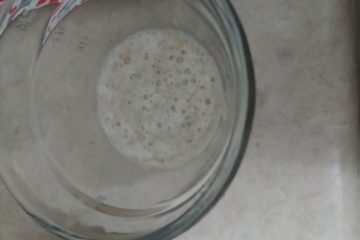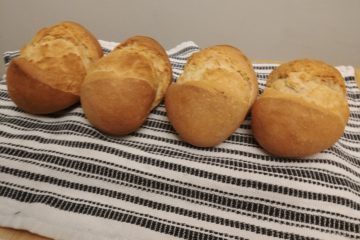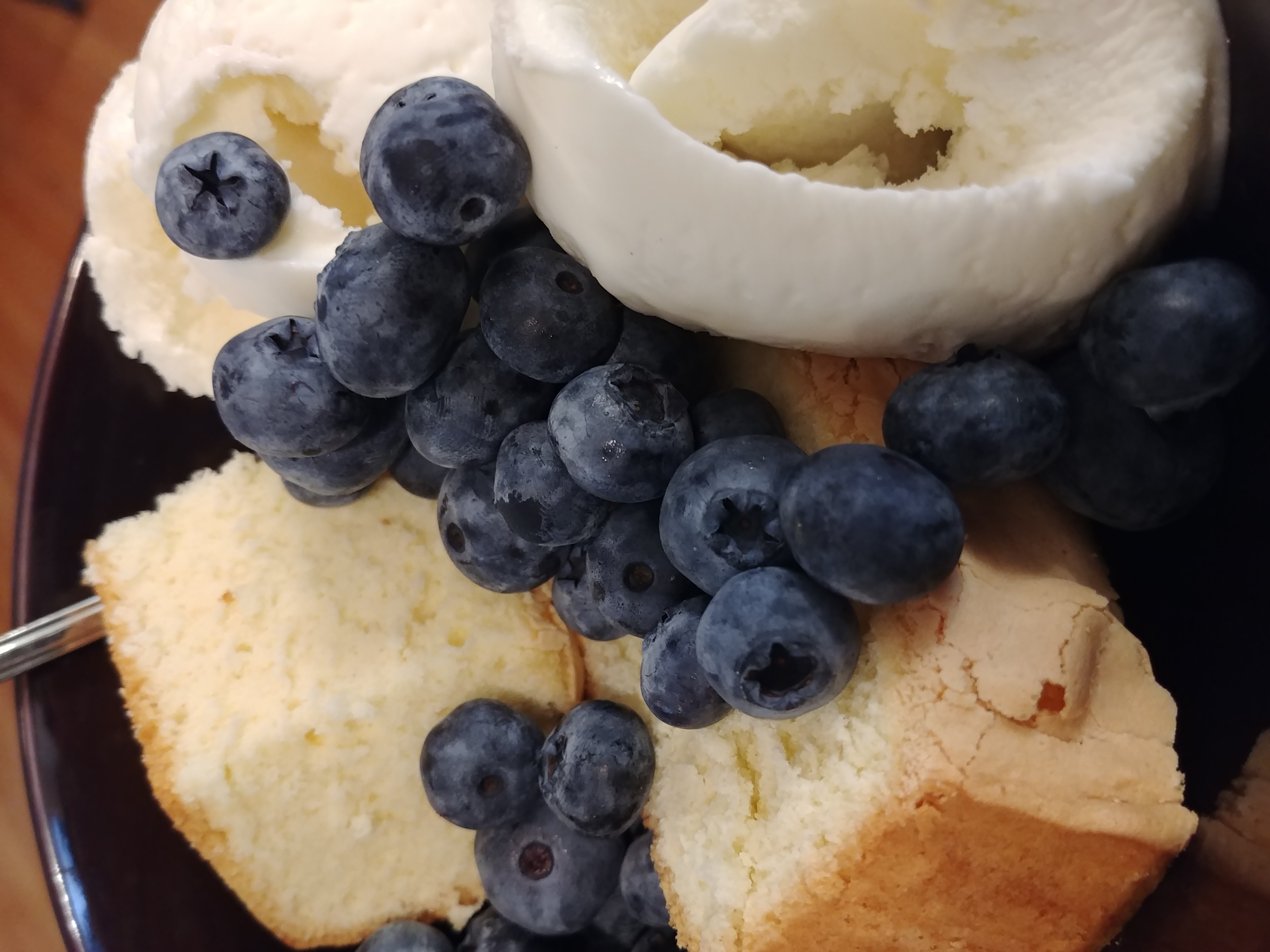9.
10.
This was done for the Barony of Lions Gate A&S Defenders competition in February 2010. The competition was that your entry had to be related to your persona, and you needed one page of documentation to show that. I made Baked Venison and Cameline Sauce. I made two kinds of Baked Venison, one with salted venison and one with fresh. I served them with a cameline sauce. Here are the highlights of my entry:
Source
Venison
When looking for a baked venison, or venison pie, recipe I found seven different recipes, sometimes from the same cookbook, spanning from 1393 till 1596. I have arranged them in order with my commentary here.
DEER VENISON. As this meat is tougher than fawn or goat, it must be parboiled and larded all along it: and in cooking, it must be put in plenty of wine, and when partly cooked, ground mace added; and it must be eaten with cameline. – Item, in pastry, let it be parboiled, larded along its length, and eaten cold with cameline. (Pichon)
Fresh VENISON PASTY. You must parboil the venison, and skim it, then lard it and make pastry: this is the way to make pasties of all fresh venison; and it should be cut in big, long pieces like rolling-pins, and this is called ‘pasty of larded boiled meat.’ (Pichon)
Le Menagier de Paris, published in 1393 has two versions of baked venison. In both cases the meat is parboiled, then larded. The only spice recommended is mace.
Venyson y-bake.—Take hogℏes of Venyson̛, & parboyle hem in fayre Water an Salt; & whan þe Fleyssche is fayre y-boylid, make fayre past, & cast þin Venyson þer-on; & caste a-boue an be-neþe, pouder Pepir, Gyngere, & Salt, & þan sette it on̛ þe ouyn, & lat bake, & serue forth. (Austin)
“Two Fifteenth-Century Cookery-Books” published in 1888 is a compilation of two manuscripts, one from 1430 and one from 1450. In this case the venison is parboiled in salted water, then laid in the pastry and a spice mixture of pepper, ginger and salt are spread on and under it. It is then baked and served hot.
To bake Veneson.
Take nothynge but pepper and salte, but lette it haue ynoughe, and yf the Veneson be leane, larde it throughe wyth bacon. (Frere)
“A Proper newe Booke of Cokerye” was published in 1557, and is the most succinct recipe. In this case the venison is not parboiled, but is just salted and peppered and then larded. Of note is that unlike the other recipes which assume you know what the term larding means this recipe reminds us that it needs to be done with bacon.
To bake Venison to eat hot. Cut the Venison in faire peeces, in quantitie as you will have your pasties, and perboyle it, that doon stick the grain side ful of Cloves, and Lard the lean side with good lard, and season it with pepper, salt, and all manner of spices; then put the grained side of the venison downwards into the coffin of brown paste, and so close it and bake it, and when it is open turn the grain side upward.
To bake Venison to eat colde. Take Venison and cut it as the graine goeth, and cut it in quantity as ye wil have your Pasties, and perboile it in faire water, then take Lard and cut it in length of your flesh, and therwith lard it as thicke as you can, so that one peece of the Larde touch not an other. Then take all manner of spices, salt, and Vinagre, that doon, put it into brown paste and bake it. (A.W.)
“A Book of Cookrye”, published in 1591, gives us two different recipes for baked venison. In both cases the venison is parboiled, and larded, but if it is to be served hot then one side of the venison is stuck with cloves (the side that will face down in the pastry). In both cases it is done in a brown paste coffin.
To bake a Red deare.
Take a handfull of Time, and a handfull of rosemarye, a handfull of winter sauerye, a handful of Bay leaues, and a handful of fennel, and when your liquor seethe that you perboyle your Venison in, put in your hearbes also, and perboyle your venison vntill it be halfe enough, then take it out and lay it vpon a faire boorde that the water may runne out from it, then take a knife and pricke it full of holes, and while it is warme, haue a faire Traye with vineger therein, and so put your Venison therein from morning vntill night, and euer now, and then turne it vpside downe, and then at night haue your coffin ready, and this done season it with synamon, ginger, and Nutmegges, Pepper and salte, and when you haue seasoned it, put it into your coffin, and put a good quantity of sweete Butter into it, and then put it into the Ouen at hight, when you goe to bedde, and in the morning draw it forth, and put in a saucer full of vineger into your Pye, at a hole aboue in the toppe of it, so that the vineger may runne into everyplace of it, and then stop the hole again, and turne the bottom upward, and so serve it in. (Dawson)
“The Good Housewife’s Jewell”, published in 1596 gives the most complex version of baked venison. The venison is parboiled in herbed water, but not to full cooking (something that may have been assumed in the other recipes), and then soaked in vinegar. It is then put in the coffin with various spices and butter and then baked, then vinegar is added to the meat prior to serving. The adding of vinegar to the venison at the end seems to have only come up in the later recipes (1590s).
Cameline
Two Cameline Sauces from Le Ménagier de Paris
CAMELINE. Note that at Tournais, to make cameline, they grind together ginger, cinnamon and saffron and half a nutmeg: soak in wine, then take out of the mortar; then have white bread crumbs, not toasted, moistened with cold water and grind in the mortar, soak in wine and strain, then boil it all, and lastly add red sugar: and this is winter cameline. And in summer they make it the same way, but it is not boiled.
And in truth, for my taste, the winter sort is good, but the following is much better: grind a little ginger with lots of cinnamon, then take it out, and have lots of toasted bread or bread-crumbs in vinegar, ground and strained. (Pichon)
Adaptation
Baked Fresh Venison
Source: Two Fifteenth-Century Cookery-Books (1450)
- 2-3 chops Fresh venison
- 2-3 liters Water
- 3 tsp Pepper
- 1 tbsp Ginger
- 2 tsp Salt
- 4-5 strips Thick cut bacon
- 1 Coffin
- ¼ cup Flour
- Take your venison and parboil it in fresh water, add salt if you wish
- Grind spices together and spread over venison on both sides
- Wrap venison in bacon, ensuring that the bacon does not overlap too much.
- Place in coffin, seal coffin with a mixture of water and flour
- Bake at 375 for about 30 min
Baked Salted Venison
Source: Two Fifteenth-Century Cookery-Books (1450)
- 2-3 chops Salted venison
- 2 liters Water
- ½ – 1 liter Red Wine Vinegar
- 3 tsp Pepper
- 1 tbsp Ginger
- 4-5 strips Thick cut bacon
- 1 Coffin
- ¼ cup Flour
- Take your venison and parboil it in 3 parts water 1 part wine vinegar
- Grind spices together and spread over venison on both sides
- Wrap venison in bacon, ensuring that the bacon does not overlap too much.
- Place in coffin, seal coffin with a mixture of water and flour
- Bake at 375 for about 30 min
Coffins
Source: Master Delbert von Straßburg adaptation
- 4 cups flour
- 200g dripping
- 1/3 cup water
- 2 tbsp salt
- 2 eggs
- Some extra flour and water mixed together into a thick paste.
- Sift the flour and salt into a mixing bowl.
- Add the water, and dripping to a saucepan and simmer, until the dripping has melted.
- Pour this mixture into the flour and salt, and stir until mixed.
- Add the eggs, stirring until the pastry forms a heavy dough.
- Roll out the pastry and cut a 20cm circle to fit in the bottom of a pie tin.
- Cut walls for the pie tin from the pastry and seal the walls to the base with the flour and water paste, making sure that all air gaps are well covered and sealed.
- Cut another circle to fit over the top of the coffin, but do not seal the coffin yet.
- Blind bake the coffin in the oven at 180C for 20 minutes or so, until the pastry hardens.
- Remove from the pie tin.
Winter Cameline Sauce
Source: Le Ménagier de Paris 1393
- Ginger 4 tsp
- Cinnamon 5 tsp
- Nutmeg 2 tsp
- Saffron medium pinch
- Red Wine 1 ¾ – 2 cup
- Bread crumbs 2/3 cup
- Water (enough to be absorbed by crumbs, not enough to drown them)
- Red sugar (brown sugar) 4-12 tsp
- Grind ginger, cinnamon, saffron & nutmeg: soak in wine.
- Moisten bread crumbs in cold water, grind them up into a paste
- Add paste to the sauce, mix thoroughly, allow to sit
- Strain once
- Boil till smooth and desired thickness
- Add sugar to taste
- Strain again if necessary
The full paper was again excessive, but was more to the point than my previous major paper. If you would like to read it in full it is here: Venison pie two ways and cameline sauce. I won this competition.



0 Comments